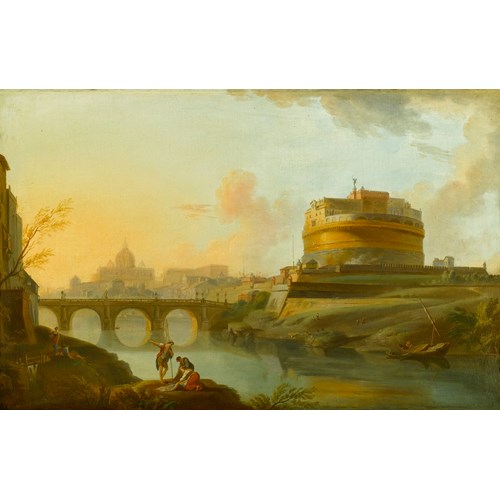Marketplace
Kolomenskoye
School Russian
Kolomenskoye
Date 19th century
Epoque 19th century, 1750-1850, 1850-1900
Origine Russia
Medium Sepia wash on paper
Dimension 10.5 x 16.5 cm (4¹/₈ x 6¹/₂ inches)
In this delightful and delicately executed watercolour, an angler sits patiently by the river’s edge, waiting for a fish to nibble on his bait; the float bobs on the water’s surface, whilst to the left, eager to assist, his dog waits at a distance for the catch to be reeled in. Behind the figure, the mouth of the Moskva River opens up, pulling the viewer’s eye deep into the background of the work. A tall tree delicately frames the left-hand side of the composition, acting as a repoussoir, its fine foliage and exposed roots casting delightful decorative patterns on the surface of the paper; behind it, on the opposite bank, the formidable architectural cluster of Kolomenskoye, with its multitude of domes and spires, rises up.
Kolomenskoye’s history dates from around 1240 when the inhabitants of Kolomna, seeking refuge from the Tatar-Mongol invaders led by Batu Khan (c.1205-1255), founded a settlement here. Situated to the south-east of Moscow, it became the site of a royal estate. Ivan the Terrible (1530-1584) lived here as a child, and again later with his first wife Anastasia (d. 1560). Kolomenskoye was also home to Peter the Great (1672-1725) during the Streltsy Uprising of 1682, as well as being the scene of festivities marking the coronations of Catherine I (1684-1727), Peter II (1715-1730) and Empresses Anna (1693-1740) and Elizabeth (1709-1762).
In 1667-1668 Tsar Alexei I (1629-1676), built a highly decorative wooden palace in Kolomenskoye on the site of a series of existing wooden structures. The palace was described as the eighth wonder of the world, and was a feat of engineering, reportedly built by carpenter foreman Semyon Petrovich and serf carpenter Ivan Mikhaylov, without the use of nails or saws. On Catherine II’s (1729-1796) order, the palace was destroyed in 1768 having fallen into disrepair. A full-scale reproduction of this impressive palace was, however, recently rebuilt using a surviving wooden models. Complete with ornate towers, cupolas, Kokoshniks, ogee-shaped roofs, spires and globes, it is a majestic sight indeed.
One of Kolomenskoye’s main surviving structures is the Ascension Church. Built in 1532 to commemorate the birth of Ivan the Terrible, the stone church is on the U.N.E.S.C.O. World Heritage List. Breaking with Byzantine domed tradition it was the first Russian ‘tent’ church. The five-domed Kazanskaya church (1662), which also remains today, formed part of the palace complex, as well as the palace’s wooden and stone gates.
Kolomenskoye’s history dates from around 1240 when the inhabitants of Kolomna, seeking refuge from the Tatar-Mongol invaders led by Batu Khan (c.1205-1255), founded a settlement here. Situated to the south-east of Moscow, it became the site of a royal estate. Ivan the Terrible (1530-1584) lived here as a child, and again later with his first wife Anastasia (d. 1560). Kolomenskoye was also home to Peter the Great (1672-1725) during the Streltsy Uprising of 1682, as well as being the scene of festivities marking the coronations of Catherine I (1684-1727), Peter II (1715-1730) and Empresses Anna (1693-1740) and Elizabeth (1709-1762).
In 1667-1668 Tsar Alexei I (1629-1676), built a highly decorative wooden palace in Kolomenskoye on the site of a series of existing wooden structures. The palace was described as the eighth wonder of the world, and was a feat of engineering, reportedly built by carpenter foreman Semyon Petrovich and serf carpenter Ivan Mikhaylov, without the use of nails or saws. On Catherine II’s (1729-1796) order, the palace was destroyed in 1768 having fallen into disrepair. A full-scale reproduction of this impressive palace was, however, recently rebuilt using a surviving wooden models. Complete with ornate towers, cupolas, Kokoshniks, ogee-shaped roofs, spires and globes, it is a majestic sight indeed.
One of Kolomenskoye’s main surviving structures is the Ascension Church. Built in 1532 to commemorate the birth of Ivan the Terrible, the stone church is on the U.N.E.S.C.O. World Heritage List. Breaking with Byzantine domed tradition it was the first Russian ‘tent’ church. The five-domed Kazanskaya church (1662), which also remains today, formed part of the palace complex, as well as the palace’s wooden and stone gates.
Date: 19th century
Epoque: 19th century, 1750-1850, 1850-1900
Origine: Russia
Medium: Sepia wash on paper
Dimension: 10.5 x 16.5 cm (4¹/₈ x 6¹/₂ inches)
Plus d'œuvres d'art de la Galerie








-Baumgartner-Stoiloff-Running from the Wolves_T637903807484877285.jpg?width=500&height=500&mode=pad&scale=both&qlt=90&format=jpg)
